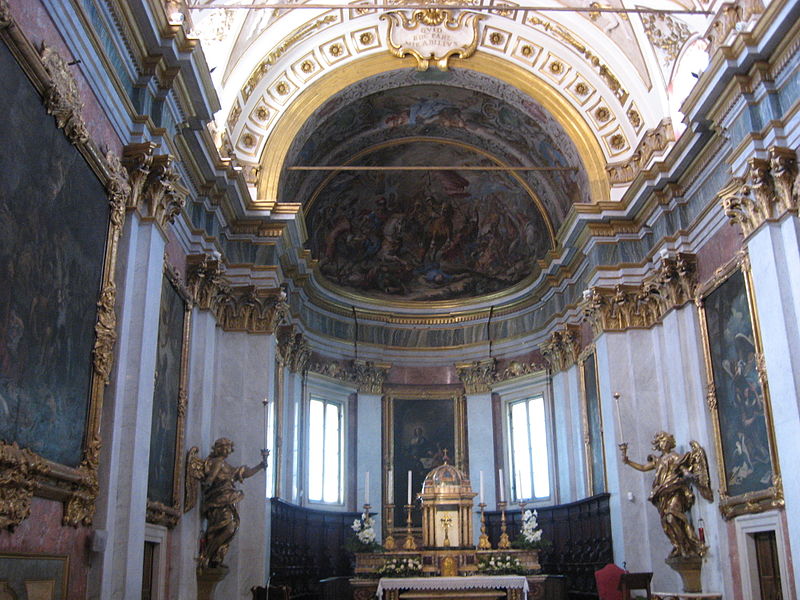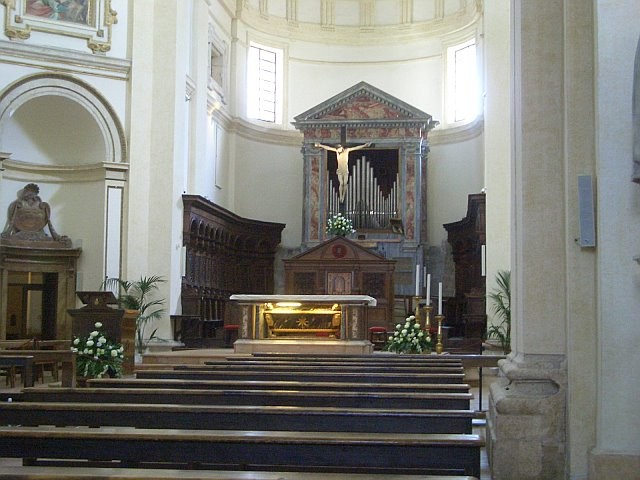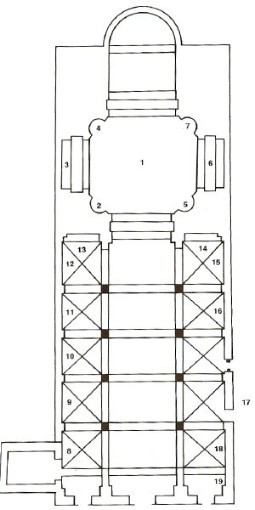|
A late night: Despite the best efforts of some noisy merrymakers out in the street just below our window, who finally shut up and went home at 3 am, both of us managed to get some sleep. Noise really reverberates because of all the pretty pink stone which gives Assisi its charm. You know the Zeffirelli movie of Romeo and Juliet? the scene (Act II, Scene 1) where Romeo's friends are trying to find him after the Capulets' party, shouting "Roooh-meo"? That's how they sounded: catcalls coalescing into a boisterous chant. Must've been someone's birthday party. We hoped it wouldn't be repeated.
Walking Tour of Assisi
We had an orientation session this morning and then went on a walk through Assisi, starting at the Piazza Santa Chiara, where our principal guide Marco Ceccarani pointed out the Bancomat (ATM) and the mail box. We then followed the Corso (Mazzini) back past our hotel and toward the Palazzo Comunale or City Hall. We passed a little shop which, according to the plaque over the door (my translation), had been a small handicraft printshop during World War II. There Luigi and Trento Brizi (father and son), printed documents which hid the true identity of Jews living in Assisi.
From there we walked to the Chiesa Nuova or New Church (1615), presumably built on the site of the house in which Francis of Assisi was born. The writing above the door says (loosely) "The house of the parents of Francis, the jail where he was confined by his father, has become a temple of God". The 1984 Roberto Joppolo bronze sculpture against the wall just to the right of the church, I Genitori di S. Francesco, are of Francis' mother and father, Pica and Pietro di Bernardone. Pica is carrying broken chains, emblematic of her releasing Francis from the prison-like enclosure Pietro had him confined to for giving away his money and goods.
From here we walked down a side alley to a small bindery and paper company, generally not open to the public, where we watched a Sicilian man named Gianfranco Alagna work, gluing paper into handmade book covers. Marco talked about the genuine handicrafts of Assisi -- papers, bookbinding and embroidery -- and the decline of handicrafts throughout Italy. Back up in the town square, we saw the shop (Piazza del Comune, 5) where Maurizio Zubboli sells those books and papers, along with other fine goods made locally. In fact, we saw Maurizio himself, who smiled and waved to us from the entry to his store (Marco seems to know everybody).
Leaving the Piazza del Comune, we trudged up the Via di San Rufino, a rather steep and narrow street leading up to go to the Duomo of San Rufino, the town's cathedral. This charming street is home to Assisi's only grocery store as well as the small shops of many artists and artisans, which seems to fit the theme of this morning's walk: the human scale of things. Marco pointed out a shop -- I don't know the name, if it has one, but the owner's name is Colombo -- where genuine Assisi embroidery made by the owner's wife can be purchased. He ran in and brought out a sample for us to examine, a beautiful hem-stitched and embroidered place mat.
The Cathedral of San Rufino
The façade of San Rufino is wonderful, covered with all sorts of interesting details and including three rose windows. The interior of San Rufino is something of mish-mash, but does contain the baptismal font where St. Francis (1182) and St. Clare (1193) were baptized. The font was created from an ancient granite column and is surrounded by an iron grating. The Blessed Sacrament Chapel in baroque style (1541, enlarged 1663), partly frescoed by Giorgetti (1663). The nine wall paintings are attributed to the 17th-century painter Andrea Carloni. The building below the bell tower is believed to have been where St. Clare's family home once stood.
Afternoon Activities
We returned to Zubolli's shop and purchased Elvio Lunghi's The Basilica of St. Francis in Assisi, which Marco had highly recommended. While we were in Piazza de Comune we dropped into Santa Maria sopra Minerva, the church built on the site, and behind the Corinthian pillars of, the original 1st century Roman Temple of Minerva. With the consent of the Bishop and municipality, the Franciscans took possession of the temple April 15, 1613. The façade is actually pictured in the first of the Giotto frescoes on the life of St. Francis (see next page, "Homage of a Simple Man"). The platform in front of the façade was for a concert to take place tomorrow night.
We returned to our room for a short nap, then attended a lecture by Marco about the Basilica and the life of St. Francis. Before we went on this trip I had ordered Francis of Assisi: A Revolutionary Life by Adrian House, on the list of recommended readings. (I'm in the middle of reading it now; it's quite good.) Went to a nearby bar, the Gran Caffé, for a cup of espresso after the talk. We sat in the empty back room where we noticed a little pug lying under one of the tables, peevishly waiting for its mistress to get off work. We returned to the classroom, which is across the Corso in the hotel annex down a short flight of stairs, where Genna Neilson, our other guide, gave us a Survival Italian lesson, essentially the same type of coverage we've had every trip to Italy. She did it well.
Unscheduled Extra -- an Evening Concert
After dinner the group gathered in front of our hotel and followed Marco and Genna to another by-way off the Piazza de Comune to a "secret destination", on the northwest corner of the intersection of Via San Gregorio and Via San Bernardo da Quintavalle (seemed like a long way down there, but it's just SW of the Comune ... see the teal-colored map on the previous page) which turned out to be a beautiful little church called San Gregorio, which dates from the 10th century. It has long been deconsecrated and is being restored. St. Francis learned his Catechism in this church.
We were treated to a piano concert by Fabrizio Ottaviucci, with works by Bach, Hayden, Chopin, Grieg and Lizst. The performance was outstanding. The pianist no longer performs in public, and he almost couldn't do this concert because of a bad cold. He's a tall, striking man, black pants and shirt with the sleeves rolled up, trimmed beard and long pony tail, probably mid-40s. We were privileged to hear him (thanks to Marco) and that we were able to hear him in this church (again, thanks to Marco; in this case he knew a representative of the Bishop).
Fabrizio Ottaviucci graduated with honors in piano at the Conservatory of Pesaro, where he studied Composition and Electronic Music. He has completed specialization courses with Tamas Vasary, held concerts in the most important cities of Italy, Austria, Germany and England and toured in USA, Canada and India. He collaborated with many highly prestigious partners on the contemporary music scene, like, Rohan de Saram, Mario Caroli, Stefano Scodanibbio, Tara Bouman, Markus Stockhausen with whom he has been intensely collaborating since 1986. He studied with composers like G.Scelsi, F. Razzi, F. Mencherini, T. Tesei the performances of their own works for piano. He works with various forms of chamber music and has been awarded prizes in several national and European competitions for his classical romantic solo repertories, mostly in virtue of the strong emotive and communicative strain inherent in his interpretation. He is deeply involved in experimental music and has held concerts with the famous jazz player Gary Peacock. He has recorded for ECM Munchen, CMP Koln, AMIATA Firenze, SPLASH Milano, WISTERIA Amsterdam and for German, English and American Radio and Television. He lives in Assisi where he runs the Intuitive Music Workshop.
|































